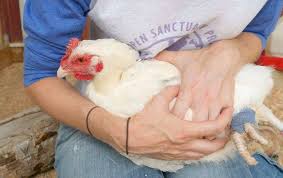Handling poultry involves capturing chickens and moving them to another area for activities like weighing or examination. Birds should be captured and handled only when necessary. The non-holding arm can assist in restraining the bird and preventing the wings from flapping.
Chickens are fragile but can become fearful if not approached gently. When removing a chicken from a cage, approach from behind and wrap hands around its body.
In a pen, calmly guide the chicken into a corner or lure it with a treat, then quickly grab it by wrapping arms around its body. Avoid chasing the chicken, as this can cause unnecessary stress. Hold the wings against the body to prevent flapping, but do not squeeze too tightly, allowing the chicken to breathe.
Lift the chicken out of the cage or off the ground, tucking it under an arm. Place one hand between the legs, gently squeezing them together while supporting it with the palm of the hand. The arm can be used to gently press the wings against the body to prevent flapping.
This method leaves one hand free for examination, such as checking the feet, taking temperature, or measuring respiration rates.
To turn the chicken around, wrap hands around its body again and, while turning it, tuck it under the opposite arm, using the hand for support and to hold the legs together. This position allows for temperature-taking and examination of the vent.
To release the chicken, hold the wings against the body and gently lower it. Ensure the feet touch the ground before letting go to avoid injury. For effective handling and restraint, it is important to first examine the chicken, identifying all physical body parts.
Read Also: Goat Milk Production Complete Guide
Checklist for Poultry Examination

1. Eyes: Bright, clear, and alert, showing no signs of discharge. Pupils should be the same size and shape on each side.
2. Nostrils: Free from discharge. Breathing should not be audible, as hearing breathing sounds without strenuous exercise may indicate illness.
3. Wattles and Comb: Should be blemish-free, with no signs of parasites around the base of the wattles.
4. Beak and Trachea: This check might require two people. One person holds the beak open while the other checks the inside for parasites such as gapeworm or throat worm. There should be no white lesions or obstructions.
5. Feathers: No bald spots, and plumage should be well-maintained and sleek. Parasites may be visible between feathers, and dull feathers may indicate a poor diet.
6. Keel Bone: The breastbone should be well-muscled. If it is pointy and sticks out, it may be a sign of undernourishment.
7. Vent: Should be clean, with no faeces around the feathers.
8. Legs and Toes: Well-scaled and smooth. Lesions or bumps could indicate conditions such as bumblefoot or pox.
Read Also: Worm Infestation on Ruminant Animals: Symptoms and Treatment
How to Carry Rabbits Safely

The most important rule when handling rabbits is to never lift them by the ears, scruff, legs, or tail, as this can cause serious damage and pain. Rabbits have fragile skeletal systems, and while they may be quick, improper handling can lead to injury.
Some rabbits tolerate being picked up, but many will struggle, making it a delicate process. It may be necessary to pick up a rabbit for tasks like nail clipping or vet checks, and doing so correctly is key.
Approach the rabbit slowly and get down to its level to put it at ease. Petting the rabbit helps calm it before lifting. When ready, scoop the rabbit by placing a hand under the torso and gently pulling it close to the body. Supporting the hindquarters is crucial to ensure the rabbit feels secure.
If the rabbit struggles, hold it firmly but be prepared to set it down carefully to avoid injury. Rabbits may attempt to leap from arms when stressed, but this can lead to serious injury.
When placing the rabbit down, squat slowly while holding it close, and gently lower it to the ground. The rabbit may thump or kick up its hind legs after being put down, showing disapproval of being handled.
Restraining a chicken or rabbit in a humane way minimizes stress and prevents injury. Techniques for handling poultry include securing the wings and lifting with support, while for rabbits, gentle handling and proper support of their fragile bodies is essential.
Effective handling ensures the well-being of the animals and allows for necessary health checks without causing harm.
Do you have any questions, suggestions, or contributions? If so, please feel free to use the comment box below to share your thoughts. We also encourage you to kindly share this information with others who might benefit from it. Since we can’t reach everyone at once, we truly appreciate your help in spreading the word. Thank you so much for your support and for sharing!
Read Also: The Effect of Heat Stress on Animal Productivity
Frequently Asked Questions
We will update this section soon.

